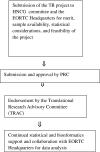Strategies to promote translational research within the European Organisation for Research and Treatment of Cancer (EORTC) Head and Neck Cancer Group: a report from the Translational Research Subcommittee
- PMID: 20305037
- PMCID: PMC2946861
- DOI: 10.1093/annonc/mdq060
Strategies to promote translational research within the European Organisation for Research and Treatment of Cancer (EORTC) Head and Neck Cancer Group: a report from the Translational Research Subcommittee
Abstract
Head and neck squamous cell cancer (HNSCC) is the sixth leading cause of cancer-related deaths worldwide. These tumors are commonly diagnosed at advanced stages and mortality rates remain high. Even cured patients suffer the consequences of aggressive treatment that includes surgery, chemotherapy, and radiotherapy. In the past, in clinical trials, HNSCC was considered as a single disease entity. Advances in molecular biology with the development of genomic and proteomic approaches have demonstrated distinct prognostic HNSCC patient subsets beyond those defined by traditional clinical-pathological factors such as tumor subsite and stage [Cho W (ed). An Omics Perspective on Cancer Research. New York/Berlin: Springer 2010]. Validation of these biomarkers in large prospective clinical trials is required before their clinical implementation. To promote this research, the European Organisation for Research and Treatment of Cancer (EORTC) Head and Neck Cancer Program will develop the following strategies-(i) biobanking: prospective tissue collection from uniformly treated patients in the setting of clinical trials; (ii) a group of physicians, physician-scientists, and EORTC Headquarters staff devoted to patient-oriented head and neck cancer research; (iii) a collaboration between the basic scientists of the Translational Research Division interested in head and neck cancer research and the physicians of the Head and Neck Cancer Group; and (iv) funding through the EORTC Grant Program and the Network Core Institutions Consortium. In the present report, we summarize our strategic plans to promote head and neck cancer research within the EORTC framework.
Figures
Similar articles
-
Strategic plans to promote head and neck cancer translational research within the radiation therapy oncology group: a report from the translational research program.Int J Radiat Oncol Biol Phys. 2007;69(2 Suppl):S67-78. doi: 10.1016/j.ijrobp.2007.04.090. Int J Radiat Oncol Biol Phys. 2007. PMID: 17848300 Free PMC article.
-
Evolution of treatment and high-risk features in resectable locally advanced Head and Neck squamous cell carcinoma with special reference to extracapsular extension of nodal disease.J BUON. 2015 Jul-Aug;20(4):943-53. J BUON. 2015. PMID: 26416042 Review.
-
INGN 201: Ad-p53, Ad5CMV-p53, adenoviral p53, p53 gene therapy--introgen, RPR/INGN 201.Drugs R D. 2007;8(3):176-87. doi: 10.2165/00126839-200708030-00005. Drugs R D. 2007. PMID: 17472413 Review.
-
Epidermal growth factor receptor targeted therapy in stages III and IV head and neck cancer.Curr Oncol. 2010 Jun;17(3):37-48. doi: 10.3747/co.v17i3.520. Curr Oncol. 2010. PMID: 20567625 Free PMC article.
-
From chemoprevention and organ preservation programmes to postoperative management: major achievements and strategies of the EORTC Head and Neck Cancer Group.Eur J Cancer. 2002 Mar;38 Suppl 4:S75-81. doi: 10.1016/s0959-8049(01)00462-2. Eur J Cancer. 2002. PMID: 11858970
Cited by
-
Oncologic treatment landscape for head and neck squamous cell carcinoma : Treatment infrastructure in German-speaking countries.HNO. 2016 Jul;64(7):494-500. doi: 10.1007/s00106-016-0188-9. HNO. 2016. PMID: 27286727 English.
-
Host proteome research in HIV infection.Genomics Proteomics Bioinformatics. 2010 Mar;8(1):1-9. doi: 10.1016/S1672-0229(10)60001-0. Genomics Proteomics Bioinformatics. 2010. PMID: 20451157 Free PMC article. Review.
-
Identification of genomic copy number variations associated with specific clinical features of head and neck cancer.Mol Cytogenet. 2018 Jan 15;11:5. doi: 10.1186/s13039-018-0354-8. eCollection 2018. Mol Cytogenet. 2018. PMID: 29371888 Free PMC article.
-
New insights into human papillomavirus-associated head and neck squamous cell carcinoma.Acta Otorhinolaryngol Ital. 2013 Apr;33(2):77-87. Acta Otorhinolaryngol Ital. 2013. PMID: 23853396 Free PMC article. Review.
-
An updated overview of HPV-associated head and neck carcinomas.Oncotarget. 2014 Jun 30;5(12):3956-69. doi: 10.18632/oncotarget.1934. Oncotarget. 2014. PMID: 24970795 Free PMC article. Review.
References
-
- Ferlay J BF, Pisani P, Parkin DM. GLOBOCAN 2002. Cancer Incidence, Mortality and Prevalence Worldwide IARC CancerBase. vol. 5. Lyon, France: IARC Press; 2004.
-
- Sant M, Allemani C, Santaquilani M, et al. EUROCARE-4. Survival of cancer patients diagnosed in 1995-1999. Results and commentary. Eur J Cancer. 2009;45(6):931–991. - PubMed
-
- Al-Sarraf M. Treatment of locally advanced head and neck cancer: historical and critical review. Cancer Control. 2002;9(5):387–399. - PubMed
-
- Chung CH, Parker JS, Karaca G, et al. Molecular classification of head and neck squamous cell carcinomas using patterns of gene expression. Cancer Cell. 2004;5(5):489–500. - PubMed
-
- Weinberger PM, Yu Z, Haffty BG, et al. Molecular classification identifies a subset of human papillomavirus–associated oropharyngeal cancers with favorable prognosis. J Clin Oncol. 2006;24(5):736–747. - PubMed
Publication types
MeSH terms
LinkOut - more resources
Full Text Sources
Medical
Miscellaneous


